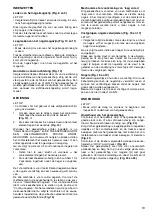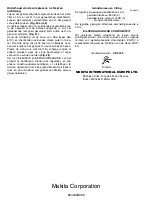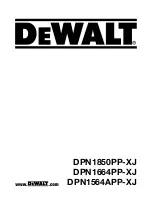
10
Jammed nailer (Fig. 16 & 17)
CAUTION:
• Always lock the trigger, disconnect the hose and
remove the nails from the magazine before cleaning a
jam.
When the nailer becomes jammed, do as follows:
Insert a small rod or the like into the ejection port and tap
it with a hammer to retract the driver. Use pliers to bend
the jammed nail so that the nail head comes out of the
slot in the driver guide. Then remove the jammed nail.
Nails (Fig. 18 & 19)
Handle nail strips and their box carefully. If the nail strips
have been handled roughly, they may be out of shape or
their connector breaks, causing poor nail feed.
Avoid storing nails in a very humid or hot place or place
exposed to direct sunlight.
MAINTENANCE
CAUTION:
• Always disconnect the hose before attempting to per-
form inspection or maintenance.
Maintenance of nailer
Always check the tool for its overall condition and loose
screws before operation. Tighten as required.
(Fig. 20)
With tool disconnected, make daily inspection to assure
free movement of the contact element and trigger. Do not
use tool if the contact element or trigger sticks or binds.
(Fig. 21)
Make sure that the trigger is locked when the change
lever is set to the LOCK position.
(Fig. 22)
When the tool is not to be used for an extended period of
time, lubricate the tool using pneumatic tool oil and store
the tool in a safe place. Avoid exposure to direct sunlight
and/or humid or hot environment.
(Fig. 23 & 24)
Maintenance of compressor, air set and air hose
After operation, always drain the compressor tank and
the air filter. If moisture is allowed to enter the tool, It may
result in poor performance and possible tool failure.
(Fig. 25 & 26)
Check regularly to see if there is sufficient pneumatic oil
in the oiler of the air set. Failure to maintain sufficient
lubrication will cause O-rings to wear quickly.
(Fig. 27)
Keep the air hose away from heat (over 60°C, over
140°F), away from chemicals (thinner, strong acids or
alkalis). Also, route the hose away from obstacles which
it may become dangerously caught on during operation.
Hoses must also be directed away from sharp edges and
areas which may lead to damage or abrasion to the hose.
(Fig. 28)
To maintain product SAFETY and RELIABILITY, repairs,
any other maintenance or adjustment should be per-
formed by Makita Authorized Service Centers, always
using Makita replacement parts.
Noise and Vibration
ENG006-1
The typical A-weighted noise levels are
sound pressure level: 89 dB (A)
sound power level: 102 dB (A)
– Wear ear protection. –
The typical weighted root mean square acceleration
value is 4 m/s
2
.
EC-DECLARATION OF CONFORMITY
We declare under our sole responsibility that this product is
in compliance with the following standards of standardized
documents, EN792 in accordance with Council Directives,
98/37/EC.
Yasuhiko Kanzaki
CE 2003
Director
MAKITA INTERNATIONAL EUROPE LTD.
Michigan Drive, Tongwell, Milton Keynes,
Bucks MK15 8JD, ENGLAND






































